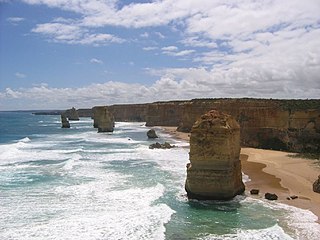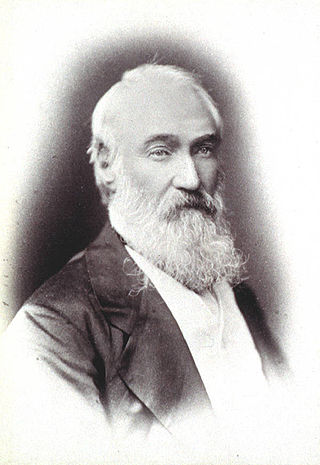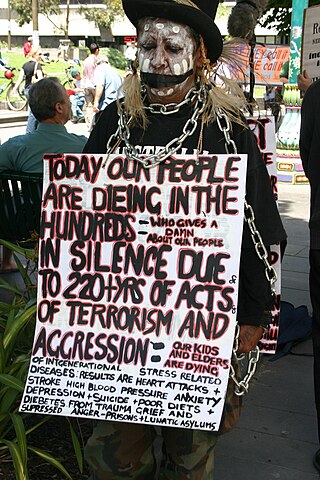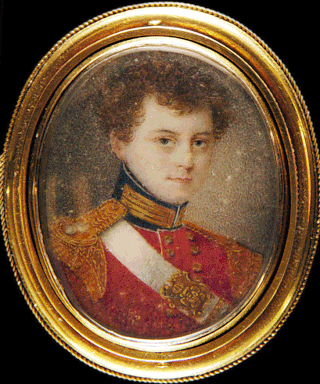Related Research Articles

The Western District comprises western regions of the Australian state of Victoria. It is said to be an ill–defined district, sometimes incorrectly referred to as an economic region,. The district is located within parts of the Barwon South West and the Grampians regions; extending from the south-west corner of the state to Ballarat in the east and as far north as Ararat. The district is bounded by the Wimmera district in the north, by the Goldfields district in the east, by Bass Strait and the Southern Ocean in the south, and by the South Australian border in the west. The district is well known for the production of wool. The most populated city in the Western District is the Ballarat region, with 96,940 inhabitants.

Foster Fyans was an Irish military officer, penal colony administrator and public servant. He was acting commandant of the second convict settlement at Norfolk Island, the commandant of the Moreton Bay penal settlement at Brisbane, the first police magistrate at Geelong, and commissioner of crown lands for the Portland Bay pastoral district in the Port Phillip District of New South Wales. He is the great-great-grandfather of actor Sam Neill.

James Whyte was a Scottish-born Australian politician who served as the sixth Premier of Tasmania, from 20 January 1863 to 24 November 1866. Before moving to Tasmania, Whyte was a pioneering sheep-farmer in western Victoria. He and his brothers perpetrated the Fighting Hills massacre of 40–80 Aboriginal people in Victoria while recovering stolen sheep.

The Cullin-la-ringo massacre, also known as the Wills tragedy, was a massacre of white colonists by Indigenous Australians that occurred on 17 October 1861, north of modern-day Springsure in Central Queensland, Australia. Nineteen men, women and children were killed in the attack, including Horatio Wills, the owner of Cullin-la-ringo station. It is the single largest massacre of colonists by Aboriginal people in Australian history.
Henry Edmund Pulteney Dana (1820–1852) established the Native Police Corps in the Port Phillip District in 1842, he was responsible for two massacres of Aboriginal people one at Barmah Lake in 1843 and the other at Snowy River in 1846. Dana was born in England, his father being Captain William Pulteney Dana of the 6th Regiment. Henry Dana migrated to Van Diemen's Land in 1840, but in 1842 he relocated to the Port Phillip District where he renewed acquaintance with Superintendent Charles La Trobe, whom he knew in London. The two men became firm friends and Latrobe appointed Dana to establish a native police corps.

The Djadjawurrung or Dja Dja Wurrung, also known as the Djaara or Jajowrong people and Loddon River tribe, are an Aboriginal Australian people who are the traditional owners of lands including the water catchment areas of the Loddon and Avoca rivers in the Bendigo region of central Victoria, Australia. They are part of the Kulin alliance of Aboriginal Victorian peoples. There are 16 clans, which adhere to a patrilineal system. Like other Kulin peoples, there are two moieties: Bunjil the eagle and Waa the crow.
The Jardwadjali (Yartwatjali), also known as the Jaadwa, are an Aboriginal Australian people of the state of Victoria, whose traditional lands occupy the lands in the upper Wimmera River watershed east to Gariwerd (Grampians) and west to Lake Bringalbert.
Murdering Gully, formerly known as Puuroyup to the Djargurd Wurrung people, is the site of an 1839 massacre of 35–40 people of the Tarnbeere Gundidj clan of the Djargurd Wurrung in the Camperdown district of Victoria, Australia. It is a gully on Mount Emu Creek, where a small stream adjoins from Merida Station.

The Gadubanud (Katubanut), also known as the Pallidurgbarran, Yarro waetch or Cape Otway tribe (Tindale), are an Aboriginal Australian people of the state of Victoria. Their territory encompasses the rainforest plateau and rugged coastline of Cape Otway. Their numbers declined rapidly following the onset of European colonisation, and little is known of them. However, some may have found refuge at the Wesleyan mission station at Birregurra, and later the Framlingham mission station, and some people still trace their descent from them.
The Campaspe Plains massacre in 1839 in Central Victoria, Australia was as a reprisal raid against Aboriginal resistance to the invasion and occupation of the Dja Dja Wurrung and Taungurung lands. Charles Hutton took over the Campaspe run, located near the border of Dja Dja Wurrung and Taungurung, in 1838 following sporadic confrontations.

The Girai wurrung, also spelt Kirrae Wuurong and Kirrae Whurrung, are an Aboriginal Australian people who traditionally occupied the territory between Mount Emu Creek and the Hopkins River up to Mount Hamilton, and the Western Otways from the Gellibrand River to the Hopkins River. The historian Ian D. Clark has reclassified much of the material regarding them in Norman Tindale's compendium under the Djargurd Wurrung, a term reflecting the assumed pre-eminence of one of their clans, the Jacoort/Djargurd.

The Rufus River Massacre was a massacre of at least 30–40 Aboriginal people that took place in 1841 along the Rufus River, in the Central Murray River region of New South Wales. The massacre was conducted by a large group of South Australian Police, who were sent to the region by the Governor of South Australia, George Grey, after Indigenous warriors carried out a series of effective raids against settler overland drives. The police were augmented by armed volunteers and a separate party of overlanders who were already battling with Aboriginal people in the Rufus River area. The colony's Protector of Aborigines, Matthew Moorhouse, accompanied the punitive expedition. He was unsuccessful in his efforts to mediate a solution before the massacre occurred.
The Battle of Broken River, also known as the Faithfull Massacre, sometimes spelt Faithful Massacre, took place in 1838 when 20 Aboriginal Australians attacked 18 European settlers, killing eight of them.
Frederick Taylor was an English mass murderer, colonial property manager and agricultural capitalist in the Victoria region of Australia. He is best known as the main perpetrator of the Murdering Gully massacre which occurred in 1839 along Mount Emu Creek near Mount Noorat. This massacre resulted in the deaths of about 40 men, women and children of the Tarnbeere gundidj clan of the Djargurd Wurrung people. Taylor was also involved in other shooting deaths of Aboriginal people near Geelong and Lake Colac. After moving to Gippsland, he was involved in the frontier conflict there with the Gunai people. Despite his responsibility for the killings being well known and well documented, Taylor was never convicted and enjoyed high esteem in British colonial society until his death in 1872.
The Eumeralla Wars were the violent encounters over the possession of land between British invaders and Gunditjmara Aboriginal people in what is now called the Western District area of south west Victoria.

Charles Wightman Sievwright was a British army officer before being appointed Assistant Protector of Aborigines in part of the Port Phillip District of the colony of New South Wales, now Victoria, Australia.
In April 1840 the Fighting Waterholes massacre of up to 60 Jardwadjali Aboriginal people of the Konongwootong Gundidj clan occurred near the current day Konongwootong reservoir, near present-day Coleraine, Victoria, Australia.
The Warrowen massacre was an apparent mass killing of Bunurong people by a group of Kurnai people in the vicinity of present-day Brighton, Victoria, Australia. It is dated to the early 1830s, close in time to the founding of Melbourne. The killing was recorded separately several years later by William Thomas and George Augustus Robinson, based on testimony from Aboriginal sources. Thomas stated that at least 60 people had been killed. According to Robinson, the massacre contributed to the end of an entire Bunurong clan, the Yowengerre, allowing a Kurnai clan to take over their territory.
The Waterloo Plains massacre occurred in June 1838 when 8 to 23 Djadjawurrung Aboriginal people were killed in a reprisal raid for the killing of two convict servants and theft of sheep.
References
- 1 2 "Our Pioneer Squatters". The Australasian. 29 July 1899. p. 49.
- 1 2 D., Clark, Ian (1995). Scars in the landscape : a register of massacre sites in western Victoria, 1803-1859 (PDF). Canberra: Australian Institute of Aboriginal and Torres Strait Islander Studies. pp. 145–152. ISBN 0855752815. OCLC 41539940.
{{cite book}}: CS1 maint: multiple names: authors list (link) - ↑ "Superintendent La Trobe and the amenability of Aboriginal people to British law 1839-1846 | PROV". www.prov.vic.gov.au. Retrieved 19 December 2018.
- ↑ "Gippsland Guardian (Vic. : 1855 - 1868) - 6 Jul 1860 - p3". Trove. Retrieved 19 December 2018.
- ↑ "Victoria places: Wando vale". Victoria places. Retrieved 19 December 2018.